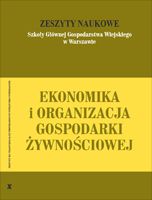Main Article Content
Article Details
AMARAL J.S., CASAL S., SEABRA R.M., OLIVEIRA B.P., 2006: Effects of roasting on hazelnut lipids, Journal of Agricultural and Food Chemistry 54, 1315-1321.
BELVISO S., BELLO DAL B., GIACOS S., BERTOLINO M., CHIRARDELLO D., GIORDANO M., ROLLE L., GERBI V., ZEPPA G., 2017: Chemical, mechanical and sensory monitoring of hot air- and infrared roasted hazelnuts (Corylus avellana L.) during nine months of storage, Food Chemistry 217, 398-408.
CIEMNIEWSKA-ŻYTKIEWICZ H., VERARDO V., PASINI F., BRYŚ J., KOCZOŃ P., CABONI M.F., 2015: Determination of lipid and phenolic fraction in two hazelnuts (Corylus avellana L.) cultivars grown in Poland, Food Chemistry 168, 615-622.
CZERNYSZEWICZ E., KOLANO A., 2004: Leszczyna Źródłem dodatkowych dochodów, Hasło Ogrodnicze 6, 7.
ĆWIERTNIEWSKI K., POLAK E., EGIERSKI K., 2005: Aktywność wody - parametr trwałości produktów spożywczych, Przemysł Spożywczy 5, 16-19.
DONNO D., BECCARO G.L., MELLANO G.M., PRIMA S., CAVICHIOLI M., CERUTTI A.K., BOUNOUS G., 2013: Setting a protocol for hazelnut rostint using sensory and colormetric analysis: Influence of the roasting temperature on the quality of Tonda Gentile delle Lange cv. hazelnut, Czech Journal of Food Science 31, 390-400.
FAMMU/FAPA, 2017: Dane handlu zagranicznego artykułami rolno-spożywczymi w 2017 roku.
FAOSTAT, 2017: Food and Agriculture Organization of the United Nations, http://www.fao.org/faostat/en/#home.
FEBRIANTO N.A., YANG T.A., Wan ABDULLAH W.A., 2016: Cocoa-like flavor compound development of rambutan seed fat as the effect of fermentation and roasting, International Food Research Journal 23, 2166-2174.
GANTNER M., 2009: Koszty ochrony plantacji leszczyny przed szkodnikami i chorobami, Progress in Plant Protection 49(1), 1610-1616.
GIACOSA S., BELVISO S., BERTOLINO M., DAL BELLO B., GERBI V., GHIRARDELLO D., GIORDANO M., ZEPPA G., ROLLE Z. 2016: Hazelnut kernels (Corylus avellana L.) mechanical and acoustic properties determination: Comparison of test speed, compression or shear axis, roasting, and storage condition effect, Journal of Food Engineering 173, 59-68.
GÖNENÇ S., TANRIVERMI H., BÜLBÜL M., 2006: Economic assessment of hazelnut production and the importance of supply management approaches in Turkey, Journal of Agriculture and Rural Development in the Tropics and Subtropics 107(1), 19-32.
GUINE R.P.F., ALMEIDA C.F.F., CORREIA P.M.R., MENDES M., 2015: Modeling the influence of origin, packing and storage on water activity, colour and texture of almond, hazelnuts and walnuts using artificial neural networks, Food Bioprocess Technology 8, 1113-1125.
KARASZEWSKI R., 2005: Zarządzanie jakością. Koncepcje, metody i narzędzia stosowane przez liderów światowego biznesu, Dom Organizatora 19.
KITA A., FIGIEL A., 2010: Wpływ temperatury prażenia na właściwości nasion słonecznika, Rośliny Oleiste 31, 133-145.
KULIK K., WASZKIEWICZ-ROBAK B., 2015: Orzechy jadalne jako Źródło składników bioaktywnych, [w:] M. Karwowska, W. Gustaw (red.), Trendy w żywieniu człowieka, Wydawnictwo Naukowe PTTŻ, Kraków, 143-156.
MASKAN M., 2001: Kinetics of colour change of kiwifruits during hot air and microwave drying, Journal of Food Engineering 48, 169-175.
MEXIS S.F., KONTOMINAS M.G., 2010: Effect of oxygen absorber, nitrogen flushing, packaging material oxygen transmission rate and storage conditions on quality retention of raw whole unpeeled almond kernels (Prunus dulcis), LWT - Food Science Technology 43, 1-11.
MICHALSKA A., ZIELIŃSKI H., 2007: Produkty reakcji Maillarda w żywności, Żywność, Nauka. Technologia. Jakość 2(51), 5-16.
MOGHADDAM M.T., RAZAVI M.A.S., TAGHIZADEH M., SAZGARNIA A., 2016: Sensory and instrumental texture assessment of roasted pistachio nut/kernel by partial least square (PLS) regression analysis: effect of roasting conditions, Food Science Technology 53(1), 370-380.
MOHAMMADI A., TABATABAEEFAR A., SHAHIN S., RAFIEE S., KEYHANI A., 2008: Energy use and economic analysis of potato production in Iran a case study: Ardabil province, Energy Conversion and Management 49, 3566-3570.
OZDEMIR F., AKINCI I., 2004: Physical and nutritional properties of four major commercial Turkish hazelnut varieties, Journal of Food Engineering 63, 341-347.
OYRZANOWSKI B., 1969: Ekonomiczne problemy jakości, Ekonomista 2, 586-597.
Rozporządzenie Komisji (WE) nr 1284/2002 Parlamentu Europejskiego i Rady z dnia 15 lipca 2002 r. ustanawiające normę handlową w odniesieniu do orzechów laskowych w łupinach, Dz.U. L 187/14.
STANKIEWICZ M.J., 2005: Konkurencyjność przedsiębiorstwa. Budowanie konkurencyjności przedsiębiorstwa w warunkach globalizacji, Dom Organizatora, Toruń.
Zawojska, A. (2008). Uwarunkowania i kanały finansowania rolnictwa w Polsce. Zeszyty Naukowe SGGW - Ekonomika i Organizacja Gospodarki Żywnościowej, (65), 98–108.
Downloads
- Katarzyna Drabarczyk, Aleksandra Jakubiec, Joanna Wrzesińska-Kowal, Consumers cooperatives in Poland in the years 2006–2014: the case study of the selected cooperative , Zeszyty Naukowe SGGW - Ekonomika i Organizacja Gospodarki Żywnościowej: No. 118 (2017)
You may also start an advanced similarity search for this article.





